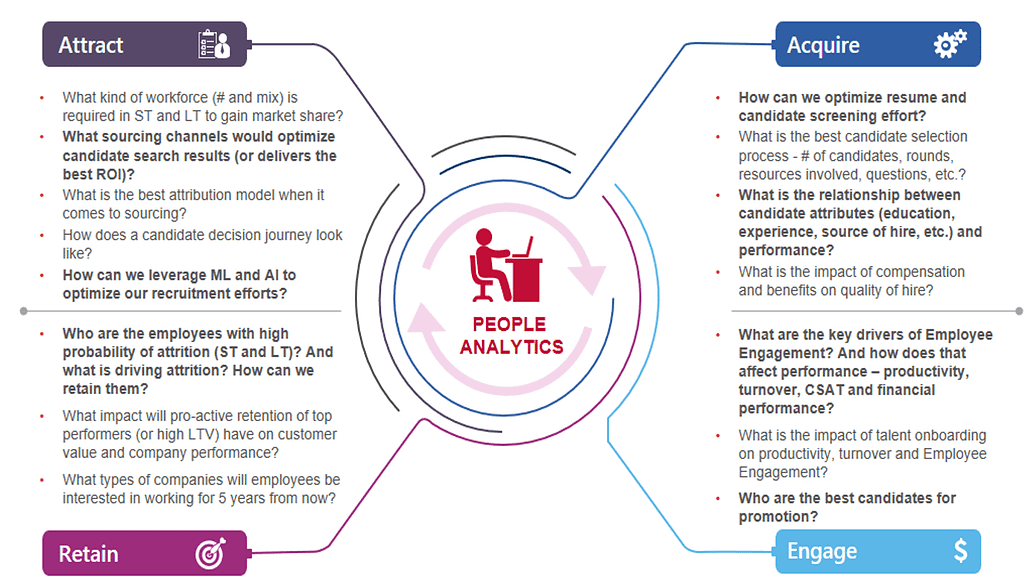Organizations today are faced with two big challenges – cost control and skillful management of human resources. As cost issues have a higher weightage, companies are aggressively and successfully addressing them through advanced analytics tools.
Human resource management, on the other hand, is restricted to traditional solutions. Is the traditional approach more effective? When all industries are going the data way, why should HR be left behind? In other words, should every modern organization adopt HR Analytics with gusto?
Before we form an opinion on the use of analytics in HR, let’s understand what HR Analytics is.
What is HR Analytics?
All companies desire a better understanding of their employees, want to connect with them, and engage them for overall growth. While involved managers can identify their team’s behaviors, can they accurately predict how each employee will perform in the long term? This is where Human Resource Analytics (HR Analytics) comes into play.
HR Analytics applies analytical processes to the HR department of an organization to identify and address problems, as well as to improve employee experience and performance. In return, organizations get an improved ROI and seamless workforce management. HR Analytics connects data, collected from different aspects of an employee’s journey, to a company’s business performance, thus enabling HR managers to make better informed decisions.
Why is its Adoption Still Low?
Any “new-age” change takes time to penetrate traditional departments – HR is no different. HR executives have been trained and are accustomed to doing things in a certain way. We believe that one of the first resistance comes from the stakeholders themselves. This unwillingness to change and apprehension about the unknown is common, and can be easily dealt with through training and education.
Another reason for low adoption is budget control. As already mentioned, issues that carry high weightage are given precedence, while HR is seldom invested into or revamped.
However, we now see that HR teams are innovating and coming out of their traditional cocoons. At Evalueserve, HR is transforming itself through analytics and digital solutions. The following sections discuss how we are achieving this.
Potential Analytics Use Cases in HR Function
Now that we are thinking about HR Analytics, let’s understand the analytical process as well as the benefits that can be expected from it. For successful analytics, one needs to figure out how to best utilize employee data. The answer lies in understanding the employee journey within a company.
Across organizations, the HR function undertakes four activities with regard to employees: Attract, Acquire, Engage, and Retain. At Evalueserve, we use HR Analytics to answer key questions related to these four activities, and eventually build robust processes for recruitment, productivity, compensation, and retention.
The key questions are listed in the following image:

Analytics and Employee Circle of Influence
Evalueserve has come up with the concept of Employee Circle of Influence, and has identified that each stage in that circle is as important as the other. Here is what happens in a typical organization:
An employee resigns → a position opens up → talent team starts the hiring process → a new employee joins → performance and productivity is measured → payment and incentives are offered → after a few cycles employee resigns → a new position opens up
At each of these touchpoints, organizations have ample opportunity to maximize employee engagement and productivity. However, to tap these opportunities, we need data. Evalueserve has been leveraging analytics to generate the following insights related to the employee journey:

Analytics Impact on Each Stage of the Circle
Here is a look at the benefits recorded by Evalueserve at each stage of the Employee Circle of Influence after adopting HR Analytics.
Reduced attrition risk through
- Categorization of employees, based on their attrition risk
- Application of sentiment and survey analytics to provide insights into upward feedback and sentiments
- Prediction of attrition risk and factors, to develop an early warning system
Expedited hiring and selection processes through
- Use of algorithm-based approach to automate the process of searching and selecting a resume, based on job description, to remove subjectivity and ensure consistency
- Comparison of lateral hire vs internal promotion
- Measurement of quality of source organizations, based on performances of past employees
- Optimization of referral process
- Adoption of high-quality hiring analysis
Identification of right compensation through
- Industry-wide compensation benchmarking
- Optimization of benefits offered by organization to help attract and retain employees
Improved employee performance through
- Analysis of tenure, skill sets, and performance to optimize performance score, based on opportunity and scope
- Identification of high-performing employees and use of attrition risk evaluators to identify the “High-Performing & High-Risk” group, as well as help address employee issues and reduce investment cost for the company
- Benchmarking of employee productivity
Robust research and policy planning through
- Prediction of employee for a proper succession planning to maintain a sustainable workforce structure
- Avoidance of discrimination
- Optimization of training experience
- Text mining with web data to identify trending and upcoming skill sets – helped in planning training for employees
- Identification of factors, such as work timing, pay, training, recognition, benefits, and transparency, which affect people’s decision to stay in the company
Is Analytics the Best Approach?
If you are looking to improve decision making across your organization, keep employees engaged and motivated, and streamline processes, you need to explore HR data. People analytics can not only help achieve these goals, but can add a lot of value to your company.
Several big organizations are already spending a lot of time and effort in researching if HR Analytics will work for them. While it does speak of benefits, there are many considerations you would need to keep in mind, including employee data privacy and ethical processing. For now, we can certainly see the HR field slowly opening up to “modern” solutions and approaches.
Analytics offers exciting benefits. The question is, are you HR Analytics ready?



